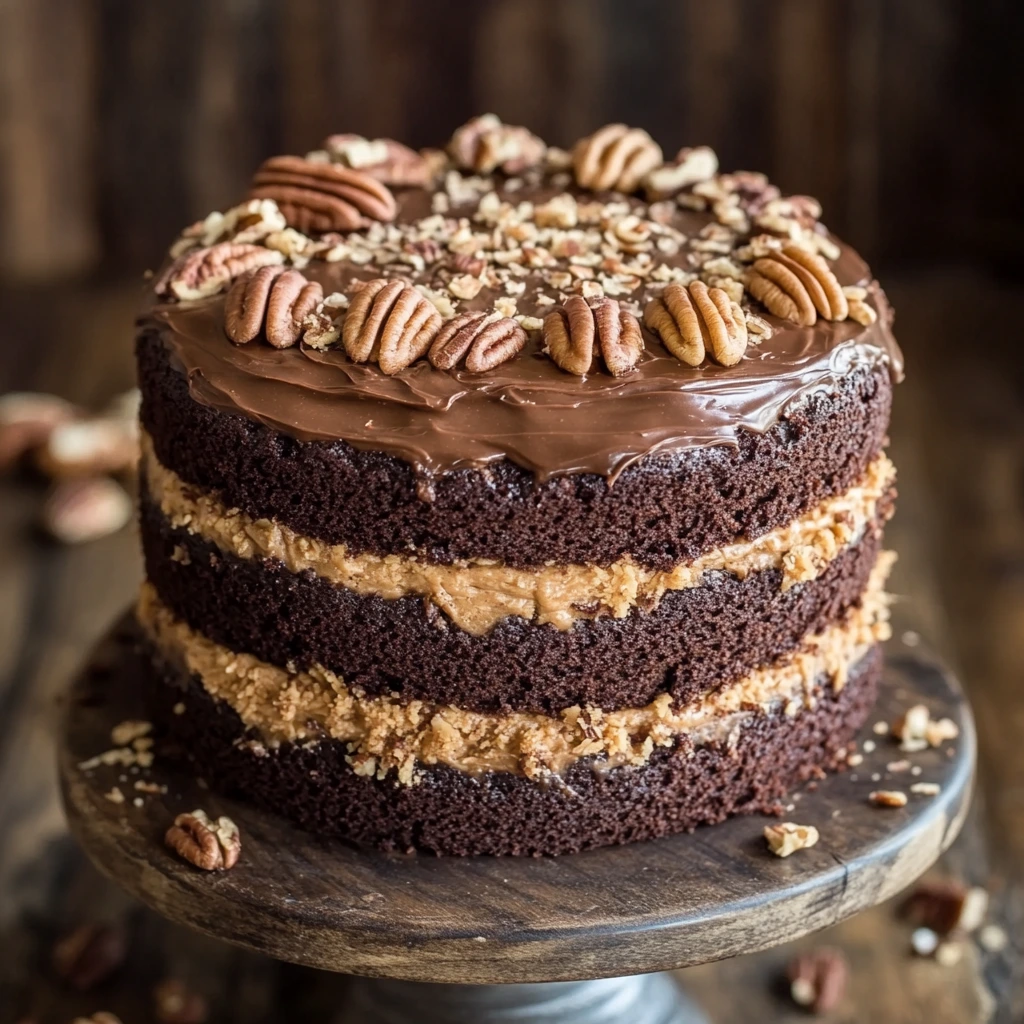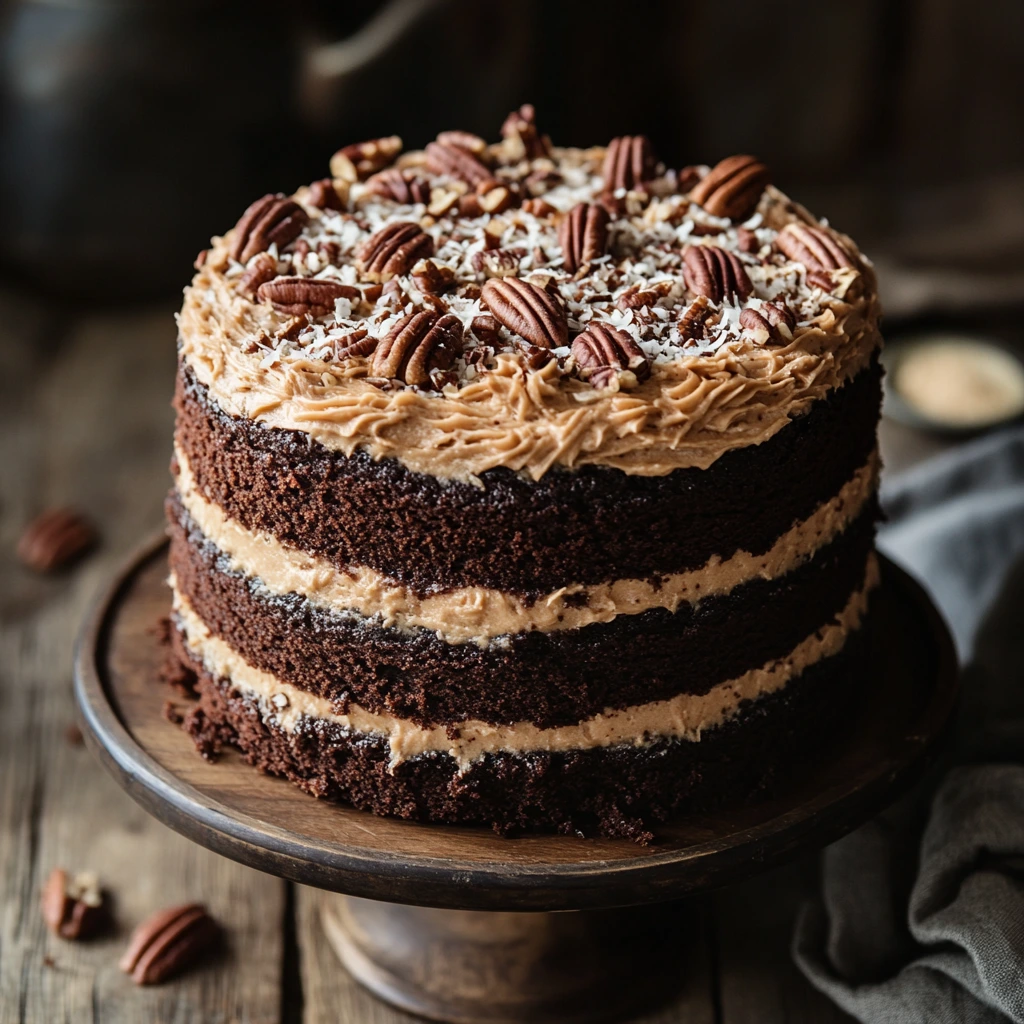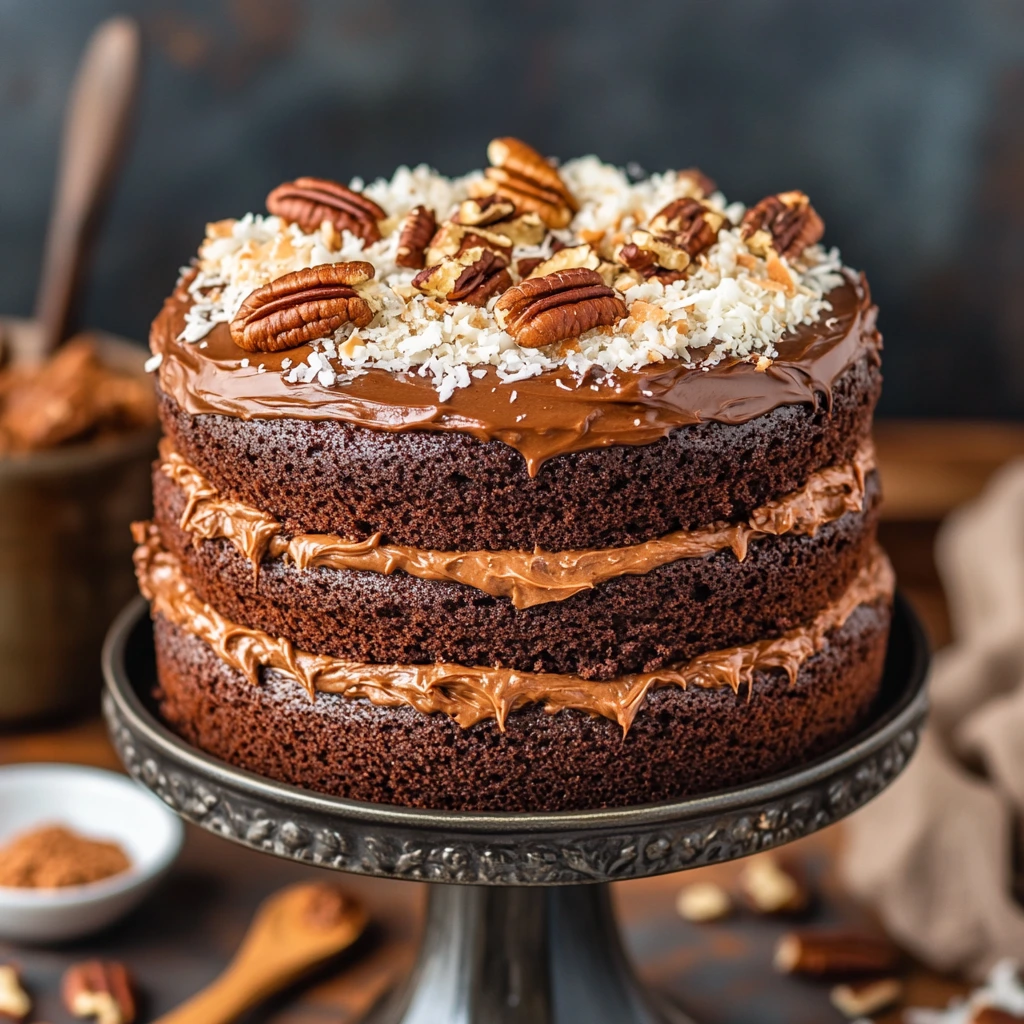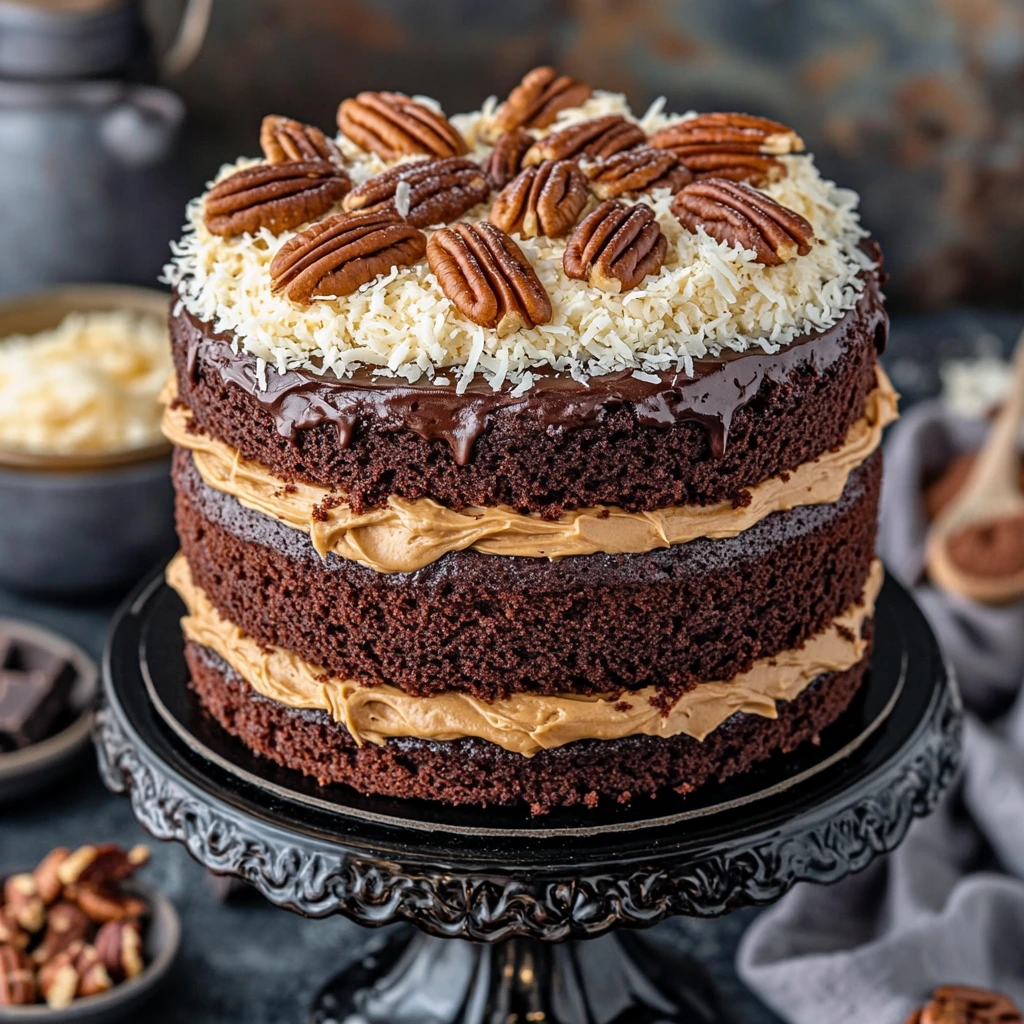German chocolate cake is a beloved dessert that has stood the test of time, delighting generations with its rich, moist layers and signature coconut-pecan frosting. Contrary to popular belief, the cake isn’t actually from Germany—its name comes from an American chocolatier, Samuel German, who created the type of sweetened chocolate that gives this cake its distinctive flavor. Whether you’re baking for a special occasion or simply satisfying a chocolate craving, an old fashioned Baker’s German chocolate cake recipe is a must-try.
In this post, we’ll walk you through the steps to create this classic dessert from scratch, using the finest ingredients like Baker’s German chocolate and the creamy coconut pecan frosting that makes this cake truly unforgettable. With a little patience and the right technique, you’ll be able to create a timeless delight that’s perfect for any celebration—or just because!

What Makes a Classic Old Fashioned German Chocolate Cake?
German chocolate cake is a beloved dessert with a unique blend of flavors, textures, and history. While many associate this indulgent treat with Germany, its origins are actually tied to an American chocolatier, Samuel German, who created the type of sweetened chocolate used in the cake. This cake has become a staple in American kitchens, especially for special occasions like birthdays and holidays. But what exactly sets a classic old fashioned German chocolate cake apart from other chocolate cakes?
The History Behind German Chocolate Cake
Although the name “German chocolate cake” might suggest a recipe rooted in Germany, it actually dates back to the United States. The cake became popular after Baker’s German’s Sweet Chocolate (the brand, not the country) was introduced by Samuel German in 1852. The first published recipe using this specific chocolate was in a newspaper in 1957, and it quickly gained national attention, especially after a woman in Texas submitted her version of the cake for a newspaper competition. From there, the cake’s fame skyrocketed, and it became a favorite dessert across the country. The name stuck, and today, German chocolate cake is considered a quintessential American treat.
Key Ingredients in a Traditional German Chocolate Cake
A classic German chocolate cake is known for its distinctive layers of moist chocolate cake and rich coconut pecan frosting. The ingredients work together to create a dessert that’s not just flavorful but has the right balance of sweetness and texture.
- Sweetened Chocolate: The foundation of any German chocolate cake is the Baker’s German Sweet Chocolate, which gives the cake its smooth, rich, and slightly sweet flavor. Unlike regular baking chocolate, this sweetened variety already contains sugar, making it perfect for cakes. It’s essential for getting that signature taste that defines this dessert.
- Coconut: Shredded coconut is a key element in the cake’s frosting. Its natural sweetness and chewy texture create a perfect contrast with the soft, moist cake. The coconut also adds a tropical twist to the otherwise rich chocolate flavor.
- Pecans: Pecans are often added to the frosting for their nutty crunch. They also bring a subtle earthiness that balances the sweetness of the coconut and chocolate. While some variations may use other nuts, pecans are traditional in German chocolate cake.
- Buttermilk: A common ingredient in classic German chocolate cake, buttermilk contributes to the cake’s tender crumb and slightly tangy flavor. The acidity in buttermilk also helps activate the baking soda, allowing the cake to rise perfectly.
- Eggs and Butter: These ingredients provide richness and structure to the cake, ensuring a moist, fluffy texture. The fat in the butter also enhances the chocolate flavor, creating a smooth and velvety mouthfeel.
The Signature Coconut Pecan Frosting
The real standout of the German chocolate cake is undoubtedly its coconut pecan frosting. This frosting is unlike the typical buttercream or cream cheese frosting found on most cakes. It’s made with a combination of egg yolks, evaporated milk, sugar, butter, and vanilla, which are cooked together until they thicken. Once the mixture cools, shredded coconut and chopped pecans are folded in to create the signature frosting.
This frosting is spread generously between the layers of the cake and on top, giving the cake its characteristic texture and a perfect balance to the rich chocolate layers. The creaminess of the frosting pairs beautifully with the slightly crumbly cake, making each bite a heavenly experience.
Step-by-Step Guide to Making the Perfect German Chocolate Cake
Making a classic German chocolate cake from scratch may sound intimidating, but with a bit of preparation and patience, you can create a rich, moist, and show-stopping dessert. This guide walks you through each stage—from preparing the batter to assembling the cake—so you can confidently bake this timeless treat in your own kitchen.

Preparing the Cake Batter
The foundation of every great German chocolate cake is a perfectly mixed batter. This is where the iconic Baker’s German Sweet Chocolate really shines.
- Melt the Chocolate: Start by gently melting the Baker’s German chocolate over a double boiler or in short bursts in the microwave. Stir until smooth and let it cool slightly.
- Cream the Butter and Sugar: In a large mixing bowl, cream room-temperature butter and granulated sugar until the mixture is light and fluffy. This helps create a tender, airy cake structure.
- Add Eggs One at a Time: Beat in the eggs, one at a time, to ensure a smooth, even batter. Eggs not only add richness but also help bind the ingredients together.
- Mix in Melted Chocolate and Vanilla: Once the eggs are fully incorporated, stir in the cooled chocolate and a splash of pure vanilla extract.
- Alternate Dry and Wet Ingredients: In a separate bowl, whisk together your dry ingredients—all-purpose flour, baking soda, and a pinch of salt. Alternately add the dry ingredients and buttermilk to the wet mixture, beginning and ending with the dry. This method helps prevent overmixing and ensures a moist, balanced cake.
Baking the Cake Layers
Even baking is key to achieving perfect layers that stack well and hold the coconut pecan frosting.
- Prepare the Pans: Grease and flour three 9-inch round cake pans or line them with parchment paper. This prevents sticking and allows the cake to release cleanly.
- Distribute the Batter Evenly: Divide the batter between the pans, smoothing the tops with a spatula. This ensures even baking and a uniform appearance.
- Bake to Perfection: Bake at 350°F (175°C) for 25–30 minutes, or until a toothpick inserted in the center comes out clean. Avoid overbaking, as this can dry out the cake layers.
- Cool Completely: Let the cakes cool in the pans for 10 minutes before transferring them to wire racks. Cooling the layers completely before frosting is essential to prevent melting and sliding.
Assembling the Cake
Now comes the fun part—putting it all together! The texture-rich coconut pecan frosting doesn’t require additional icing, making assembly simple yet stunning.
- Make the Coconut Pecan Frosting: While your cakes cool, prepare the frosting by cooking egg yolks, evaporated milk, sugar, and butter in a saucepan over medium heat. Stir constantly until thickened. Remove from heat and stir in vanilla, shredded coconut, and chopped pecans. Let it cool to room temperature.
- Layer the Cake: Place the first cake layer on a serving plate or cake stand. Spread a generous amount of frosting on top, letting it slightly spill over the edges. Repeat with the second and third layers.
- Top and Finish: Finish by spreading the remaining frosting on the top layer. German chocolate cake is traditionally not frosted on the sides, allowing the delicious layers and textures to show.
Why Is Baker’s German Chocolate Essential for This Recipe?
When it comes to making an authentic old fashioned German chocolate cake, not just any chocolate will do. The true magic lies in the use of Baker’s German Sweet Chocolate—a key ingredient that gives this cake its signature flavor, texture, and history. But what makes this particular chocolate so special? Let’s dive into why Baker’s German chocolate isn’t just a brand name—it’s the heart of the recipe.
The Origin of Baker’s German Chocolate
The story of German chocolate cake begins with Samuel German, an English-American chocolatier who, in 1852, developed a mild, sweetened baking chocolate for the Baker’s Chocolate Company. Unlike unsweetened or bittersweet varieties, this chocolate was made with added sugar and had a uniquely smooth, mellow flavor. It was initially called “German’s Sweet Chocolate” in his honor.
Fast forward to 1957, when a Texas homemaker submitted a recipe for a cake using this chocolate to a local newspaper. The recipe—originally titled German’s Chocolate Cake—became an overnight sensation. Eventually, the possessive apostrophe was dropped, and the cake became known as simply German chocolate cake, forever linking it to the Baker’s brand.
What Makes Baker’s German Chocolate Different?
So, why does Baker’s German chocolate stand out in baking, especially for this recipe?
- Sweetened Chocolate Profile
Unlike traditional unsweetened baking chocolate, Baker’s German chocolate contains added sugar, giving it a naturally mild and sweet flavor. This means you don’t have to add as much extra sugar to the batter, resulting in a perfectly balanced sweetness that doesn’t overpower the other ingredients—especially the rich coconut-pecan frosting. - Smooth, Mellow Flavor
The chocolate has a lower cacao content (around 48%) compared to dark or semi-sweet chocolate, which gives it a more delicate, creamy taste. This flavor complements the earthy richness of pecans, the chewy sweetness of coconut, and the buttery, eggy base of the frosting, tying everything together without overwhelming the palate. - Soft Melting Quality
Baker’s German chocolate melts easily and smoothly, making it ideal for folding into cake batter. It creates a soft crumb and moist texture, essential for the light, fluffy cake layers this recipe is known for. The result is a cake that’s rich but not dense—perfect for stacking and layering with generous helpings of frosting.
Why Substitutions Just Don’t Compare
While you can substitute semi-sweet chocolate or dark chocolate in a pinch, doing so will significantly alter the flavor and texture of your cake. Semi-sweet chocolate has a more intense cocoa flavor and less sugar, which can make the cake taste too rich or even slightly bitter. Similarly, unsweetened chocolate will require extra sugar adjustments in the recipe and still won’t capture the authentic flavor of the original.
Baker’s German chocolate is also free from additives and preservatives, giving your dessert a homemade purity that’s hard to beat. If you’re aiming for a true, classic German chocolate cake experience, using the right chocolate isn’t just a recommendation—it’s a must.
Tips and Tricks for a Moist and Delicious German Chocolate Cake
A truly great German chocolate cake is known for its moist, tender crumb and rich, flavorful layers. While following a good recipe is key, there are a few insider tips and tricks that can take your cake from good to unforgettable. Whether you’re a first-time baker or a seasoned pro, these pointers will help you create a cake that’s soft, rich, and packed with flavor every single time.

1. Use Room-Temperature Ingredients
This might sound like a small detail, but it makes a big difference. Using room-temperature butter, eggs, and buttermilk helps them blend more smoothly into the batter, resulting in a more even texture. Cold ingredients can lead to a lumpy batter and uneven baking.
Tip: Take your ingredients out of the fridge at least 30 minutes before baking.
2. Don’t Skip the Buttermilk
Buttermilk is a secret weapon for creating a moist and tender crumb. Its slight acidity interacts with the baking soda in the recipe, helping the cake rise and adding a subtle tang that balances the sweetness of the chocolate and frosting.
Substitution Tip: If you don’t have buttermilk, you can make a quick version by adding 1 tablespoon of white vinegar or lemon juice to 1 cup of milk. Let it sit for 5–10 minutes before using.
3. Melt the Chocolate Gently and Let It Cool
Baker’s German Sweet Chocolate has a delicate texture and flavor. Melting it slowly—either in a double boiler or at low power in the microwave—prevents it from burning or seizing. Let it cool slightly before adding to your batter so it doesn’t scramble the eggs or alter the batter’s consistency.
Pro Tip: Stir the chocolate continuously while melting to ensure a smooth, even texture.
4. Measure Your Flour Correctly
Using too much flour can make your cake dry. The best way to measure flour is to spoon it into your measuring cup and level it off with a knife. Scooping directly from the bag or container can pack in extra flour, which throws off the balance of wet and dry ingredients.
Optional Upgrade: Weighing ingredients with a kitchen scale provides the most accuracy, especially for baking.
5. Don’t Overmix the Batter
Once you combine the dry ingredients with the wet, mix just until everything is incorporated. Overmixing can develop the gluten in the flour, leading to a denser, tougher cake. You want a light hand here—mix until you no longer see streaks of flour, then stop.
6. Keep an Eye on Bake Time
Baking too long is one of the most common reasons cakes turn out dry. Start checking your cake a few minutes before the recipe suggests. Insert a toothpick into the center of the cake—if it comes out with just a few moist crumbs (not wet batter), your cake is ready.
Baking Tip: Your oven might run hot or cold. Use an oven thermometer to make sure it’s truly at 350°F (175°C).
7. Let the Cake Cool Completely Before Frosting
This is especially important with coconut pecan frosting, which can melt and slide right off if the cake is even a little warm. Allow the cake layers to cool completely on wire racks before you begin assembling.
Cooling Hack: Bake your layers a day ahead and wrap them in plastic wrap. Chill overnight to make frosting and stacking easier.
Variations of the Classic German Chocolate Cake Recipe
While the classic German chocolate cake is beloved for its rich, chocolatey layers and indulgent coconut-pecan frosting, there are plenty of ways to give this traditional dessert a personal twist. Whether you’re looking to customize the flavor, create a more modern version, or add a little extra flair, there are many exciting variations to explore. Let’s take a look at some creative ways to put your own spin on this iconic cake.
1. German Chocolate Cupcakes: A Single-Serving Delight
If you love the classic German chocolate cake but want to make it a bit more portable or easier to serve, German chocolate cupcakes are a great alternative. These mini versions of the cake are ideal for parties, picnics, or even as a special treat for your family.
- How to Make Them: Follow the same recipe for the cake batter, but divide it into cupcake liners, filling each about 2/3 full. Bake at the same temperature but reduce the baking time to about 18-22 minutes, checking for doneness with a toothpick.
- Frosting Tip: Pipe the coconut pecan frosting onto each cupcake or spoon it generously on top for that classic finishing touch.
2. Chocolate Variations: Dark, Milk, or White Chocolate
If you want to experiment with different chocolate flavors, you can easily swap out the Baker’s German Sweet Chocolate for other types of chocolate.
- Dark Chocolate German Cake: Swap the German sweet chocolate with high-quality dark chocolate (around 70% cocoa) for a richer, more intense flavor. The deep cocoa notes will complement the sweetness of the frosting.
- Milk Chocolate German Cake: For a sweeter, creamier version, you can substitute milk chocolate. The cake will have a milder flavor profile, which might pair well with a lighter frosting.
- White Chocolate German Cake: For something truly unique, use white chocolate. It will provide a smooth, creamy texture and a sweeter flavor, offering a delicious contrast to the nutty coconut-pecan frosting.
3. Coconut-Free Version for Picky Eaters
While coconut is a signature ingredient in the frosting, some people may not enjoy the texture or flavor of coconut. If that’s the case, you can make a coconut-free German chocolate cake while still preserving the traditional flavor.
- How to Modify: Simply omit the coconut in the frosting and replace it with extra chopped pecans or walnuts for added texture. You could even add a layer of rich caramel or a ganache topping for a modern twist.
- Flavor Tip: You can incorporate toasted pecans directly into the batter for a nutty, flavorful crumb that still gives the cake that signature richness.
4. Adding Berries: A Fruity Twist
For a fresh and fruity variation, try adding berries to your cake or frosting. Fresh fruit can balance the richness of the chocolate and add a bright, tart contrast to the sweetness.
- Berry-Infused Cake: Fold in fresh raspberries, strawberries, or even blueberries into the batter for a surprising pop of flavor in every bite. The berries will create small pockets of juiciness and color in the cake.
- Berry Frosting: For a playful twist, fold mashed berries into your coconut-pecan frosting for a unique flavor profile. A bit of raspberry or strawberry puree will enhance the frosting’s texture and color, while still keeping the essence of the original recipe.
5. Gluten-Free German Chocolate Cake
For those who are gluten intolerant or prefer a gluten-free option, you can make a gluten-free version of the German chocolate cake without sacrificing flavor or texture.
- Flour Substitution: Replace the all-purpose flour with a high-quality gluten-free flour blend (one that includes xanthan gum for structure) to maintain the cake’s fluffiness. You could also try using almond flour for a denser, slightly nutty flavor.
- Ensure Moisture: Gluten-free cakes can sometimes be drier than traditional ones, so you may want to increase the amount of buttermilk or add a bit of extra oil or applesauce to keep the cake moist.
- Frosting Tip: The coconut-pecan frosting is naturally gluten-free, so you can enjoy it just as you would with the classic version!
6. Vegan German Chocolate Cake
For a plant-based take on the classic German chocolate cake, you can easily make it vegan by substituting the animal-based ingredients.
- Egg Substitute: Use flax eggs (1 tablespoon of ground flaxseed mixed with 3 tablespoons of water per egg) or applesauce as an egg replacer.
- Butter Substitute: Replace the butter with vegan butter or coconut oil for a dairy-free option.
- Milk Substitute: Swap the buttermilk with almond milk or soy milk, and add a tablespoon of vinegar or lemon juice to mimic the tanginess of buttermilk.
- Vegan Frosting: You can also make the coconut-pecan frosting vegan by substituting coconut milk for the dairy ingredients. The result is a rich and creamy frosting that pairs perfectly with your moist vegan cake.
7. Layered Cakes and Cake Roll Variations
For a more elegant presentation, you can turn your German chocolate cake into a layered dessert or even a cake roll.
- Layered Cake: Stack the layers high and fill between each layer with extra coconut-pecan frosting. This will make your cake even more decadent and impressive.
- German Chocolate Cake Roll: Bake the cake in a sheet pan and spread the frosting evenly on top. Roll it up like a Swiss roll and slice it into individual servings. This variation gives a fun twist on the traditional presentation and is perfect for smaller gatherings.
Final Thoughts
The versatility of the classic German chocolate cake recipe allows for many delicious twists. Whether you want to make it gluten-free, add fruit, or play with different types of chocolate, these variations will help you customize your cake to suit any taste preference. Each one offers a unique take on this beloved dessert while maintaining the essential qualities that make German chocolate cake so unforgettable.
Which variation are you excited to try? Let me know if you’d like more ideas for custom toppings or frosting styles!
Chef’s Note
As a chef, I can tell you that German chocolate cake is one of those timeless desserts that never goes out of style. Whether you’re sticking to the classic recipe or experimenting with a fun variation, what matters most is the love and care you put into baking. The key is to use quality ingredients, follow the steps carefully, and allow yourself to get creative with the flavors.
Remember, a great cake isn’t just about the end result—it’s about enjoying the process, learning along the way, and sharing the fruits of your labor with loved ones. So, don’t be afraid to try new variations, tweak the recipe to your preferences, and make this classic your own.
Happy baking, and may your kitchen always be filled with the delicious aroma of freshly baked German chocolate cake! 🍫🎂

